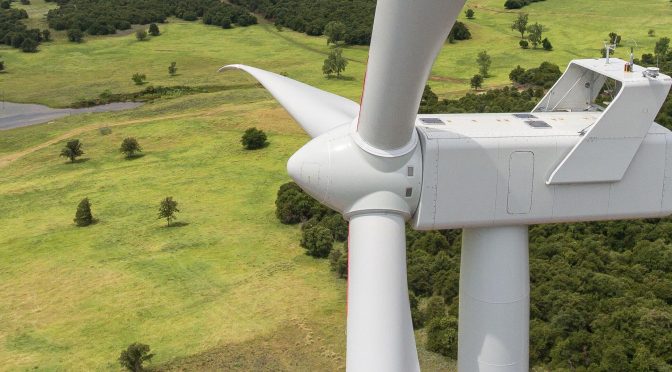March 18 is Global Recycling Day. Separating waste and developing the circular economy helps protect our planet’s future: here are some examples of EGP’s innovative role, especially in the fields of electric batteries and wind turbines.
Recycling is a fundamental part of the circular economy and one of the Sustainable Development Goals (SDGs) of the UN’s 2030 Agenda. According to the data from the Global Recycling Foundation, recycling saves over 700 million metric tons of CO2 emissions per year, and that number is expected to rise to one billion metric tons by 2030.
Enel Green Power (EGP) is carrying out several different recycling and reuse projects, ranging from water to wood to construction materials, in the many countries where it operates. There are two in particular that have to do specifically with the technologies used in renewable energy plants.
New life for wind power
The first wind farms date back to the early 2000s and have an average lifespan of 30 years. Repowering projects can extend their life, but replacement pieces require sustainable disposal solutions. Most of the components of a wind turbine are easily recycled because they are made of metal. The blades, on the other hand, are harder to recover because they are made of composite materials, like resin reinforced with fiberglass or carbon fiber, as well as secondary materials like glues, paints and metals.
That’s why EGP is spearheading the Wind New Life project to develop a circular value chain for the end-of-life management of decommissioned blades. The Compostilla complex in Spain, for instance, will build a turbine blade recycling plant: it will process more than 6,000 tons of fiberglass and carbon per year, turning it into secondary materials that can be reused to make high value-added components (for construction materials, furniture and bathroom fixtures, plumbing, and street cabinets).
Another possible destination for decommissioned blades is turning them into electricity poles (which will be tested in the United States in the upcoming months within the framework of the Re-Wind project) or integrating them into the blocks used by Energy Vault for gravitational storage. The Swiss company is testing a purely mechanical technology inspired by hydroelectric plants to store energy using massive blocks of solid material: they are lifted to store electricity when an excess of energy is produced and then, when electricity is needed, the blocks are lowered using the force of gravity to generate electricity as they descend. The composite material from the recycled blades makes these blocks more stable and robust.
Focusing on new materials
This commitment to recycling and innovation also involves the design of the products themselves, in line with the Enel Group’s Open Innovability® approach. The Swedish startup Modvion, for example, is developing wind turbine towers made of wood rather than steel, with expected benefits not just in terms of sustainability, but also in terms of logistics and installation costs: thanks to a modular system, the towers are assembled on-site and can be transported much more easily.
The Scottish company ACT Blade has specialized instead in the production of innovative wind turbines covered with a special technical fabric similar to the material used for the sails of racing yachts competing in the America’s Cup. The turbine blades are lighter because they have a slender supporting structure made of composite material; moreover, the components are easier to separate and recover, and the technical fabric covering them is completely reusable.
New life for electric batteries
Another important chapter in Enel Green Power’s commitment to recycling and innovation involves reusing batteries for electric vehicles (especially the Nissan LEAF model): they are recycled and assembled in a large stationary storage system, which accumulates energy to support the stability of Melilla’s power grid. The Spanish town is located on the African coast and is separated from the rest of Spain; the same goes for its local electricity network, which is powered by a thermal plant and is isolated from the national distribution grid. The solution developed by EGP in collaboration with Nissan involves reusing over ninety electric car batteries and connecting them together to provide a total available charge of up to 4 MW, with a maximum accumulated energy of 1.7 MWh.
The Compostilla complex in Spain is also designing an innovative system for the end-of-life management of batteries. In the recycling process, they are discharged, dismantled, crushed, and the materials are selected to be reintroduced into the production cycle of new batteries.
How solar panels are reborn
Circularity is the focus of several activities in the solar energy sector as well. Enel, together with other companies and research institutes, is participating in the European project Photorama: its goal is to develop innovative technologies to recycle end-of-life photovoltaic panels and production waste, and to recover over 95% of secondary raw materials that can be reintegrated into the solar supply chain.
The Spare Parts and Equipment New Life project is also participating in circular economy initiatives. This project, which was launched in February 2020, gives new life to spare parts and equipment from power plants slated for closure or conversion; not only does it decrease their environmental impact by preventing these materials from ending up in landfills, it also generates savings thanks to internal reuse, sale and recycling.
These are just a handful of examples, but Enel Green’s circular approach involves the entire value chain, starting with our partners. Which is why we’ve introduced global sustainability criteria to evaluate our suppliers: they include the use of renewable energy, sustainability certification along the entire production chain, and, last but not least, applying the principles of circularity, especially when it comes to using recycled materials.


